Sport of Tennis Permanently Concluded
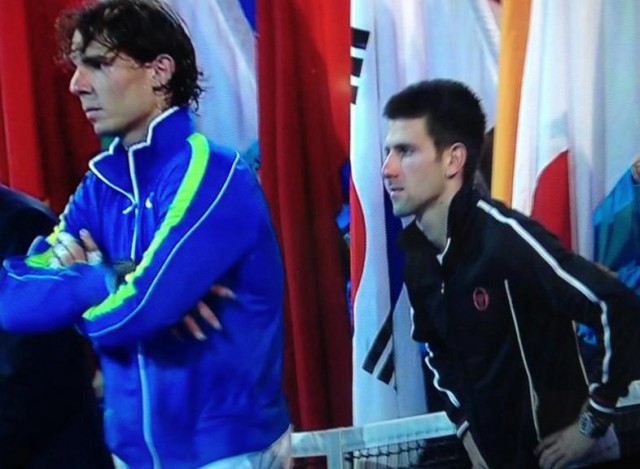
Over the weekend in the far-off and forgotten colony of Australia, a long-standing problem in athletics was finally solved! Tennis, a thorny question that first began plaguing the English in the 19th century, is now complete, with the conclusion of a record five-hour-and-53-minute match to end the Australian Open. Ecstatic with their work, Rafael Nadal and Novak Djokovic pretty much nearly barfed during the trophy ceremony. (Nadal actually sat on the net; Djokovic was pretty much face-to-knees; finally, two little convicts scurried onto the court with chairs for the pair.)
We expect word later today from the upcoming Sony Ericsson and then the U.S. Open about their cancellations, now that tennis is done.
How To Bring A Bike On The New York City Subway
by Jay Casey
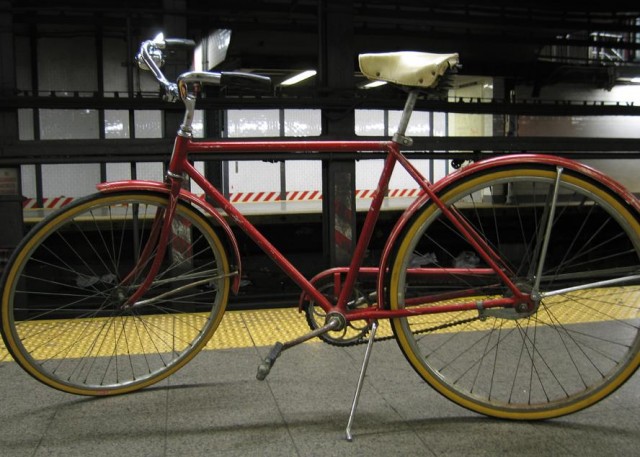
1. Don’t.
2. If you have to ride the subway, everyone else comes before you. It’s known as yielding.
3. Is it rush hour? Don’t bring your bike on the subway.
4. “But I just have to ride the train during rush hour!” Then only outbound in the morning, and inbound in the evening. Otherwise, you’re an incorrigible imp. And you’ll probably get a ticket.
5. At the turnstile, signal the MTA attendant in the booth by waving your arms wildly and gesturing to the gate (is there no booth at the entrance? Go the hell back upstairs and enter at a booth station entrance), swipe your Metrocard, spin the turnstile arm, walk over to the emergency entrance (if you didn’t muck it up, the booth attendant will have unlocked it), walk through.
6. Don’t ever, ever, ever carry your bike over a turnstile.
7. Stairs? You go last. (And now you must carry your bike.)
8. On the platform, make room. Plan to enter at either end of the train car.
9. Once on the train, don’t sit down.
10. Don’t lean your bike anywhere.
11. Don’t lock your bike to a pole.
12. Don’t straddle the frame.
13. Don’t ride it.
14. Use the same attention you reserve for riding around buses and garbage trucks. Because, instead of dealing with wheels that will crush your skull, you have a train full of people who want to stab you until your intestines are a puddle on the subway car floor.
15. Hold the bar, hold your bike. In the event of sudden movement or (God forbid) an accident, you’ve just introduced a metal projectile to the train car.
16. Stand by the doors, you need to exit first. Last on, first off. Find a clear area on the platform. Wait a minute or two (or whenever the platform/stairs look empty, you weakest of the species), then make your next move.
17. In a city full of opinions, there’s only one person whose judgment matters in this situation: Police. Listen up, or look forward to your marmalade p.b. & j. sandwich in The Tombs.
Jay Casey will be the first one to stab you. You can learn more about the MTA’s rules and guidelines for bicycles here! You should try it! Photo by Pete Jelliffe.
Gucci Mane, "North Pole"
The lyrics are Christmas themed. The beat and the video, more appropriate for Halloween. But Gucci Mane is Gucci Mane, so he’ll put it out late January. Sort of in time for Valentine’s Day.
How They Got There: A Conversation With Chiropractor Bill Walsh
by Noah Davis
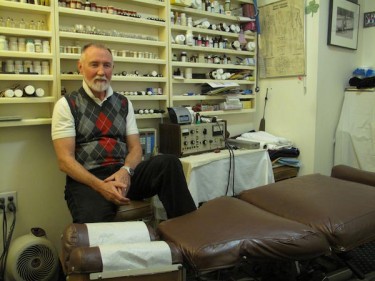
Bill Walsh will openly admit that his many former bosses were justified when they fired him. He was “arrogantly unfit,” and is not shy about telling tales of his, shall we say, youthful misadventures. Eventually, Walsh righted himself, joined a recovery program, went to chiropractic school, and started a practice in Park Slope. He’s been treating people there for the past 25 years.
At Plaza Center for the Healing Arts, Walsh combines his talent for manipulating the spine with an encyclopedic knowledge of anatomy, the body’s relationship to itself, and a homeopath’s understanding of drugless cures. He enables his patients to make themselves better. “My job is to place myself in people’s rearview mirror, getting ever smaller as they drive away,” he says.
In an exam room of the brownstone where he has his practice, Walsh talked about missteps, recovery and the art of getting there eventually.
How did you get here, sitting in a room where bottles filled with homeopathic remedies line the walls and a chiropractic table sits between us?
I had a desire to be a doctor from my earliest days. I was sidetracked academically and when I got back on track, one of the people who helped me was a physician. He was eager to help me help myself. It was he who suggested that if I wanted the kind of practice that was a drugless healing profession — one that would fill needs of people in recovery — I shouldn’t go to medical school. He said osteopathy or chiropractic school.
Before I did that, I was teaching with Marty Skoble [at St. Ann’s]. I started in recovery in the late ’60s and early ’70s, and I finally realized that I didn’t have to just teach, which is what I started doing as soon as I graduated from college. That kept me out of the draft, and revealed to me that I had a talent for teaching. I continued doing that and once I found recovery, I realized I could do other things. I did any number of other things, most of which I wasn’t very good at.
Such as?
I was a private investigator. I worked for Pinkerton’s. I was a security guard. I worked for the phone company. It’s quite a list, and they all end in stories that would humiliate any reasonable person. I discovered that my daughters loved when I embraced my humiliation and turned it into stories I would tell them. They would just roar. I wouldn’t leave out that I was not only unfit, but arrogantly unfit, for these jobs. My daughters would say, “No wonder they fired you. You were a jerk.” And I would say, “Well, yes. That’s the point of the story. When I drink, I’m a jerk.”
One of the things that recovery does is it makes you look at your life and figure out what your assets are. I remember thinking that I could get back on track with the things that I already knew I was good at. This is the thing that the world offered someone with my skillsets.
When did you start to pursue your current path?
That was in ’76, and I was six years sober at the time. Fred, a really wonderful fellow who I met in recovery, was the one who turned me on to chiropractic school. By 1978, I left St. Ann’s, which was until this, the best gig ever. St. Ann’s was heaven. I had the richest group of colleagues ever and the most awesome students. I had a mandate to love my subject and love my students. It was very clear: If I was following both of those mandates, they thought highly of me.
Even though you were riding a motorcycle to work?
Yeah, I had a motorcycle back then. I was still growing up. I thought of myself as a romantic figure riding 12 months a year in New York City. I thought that was really something special. [Laughs] I was to discover that it wasn’t all that special; it was just silly and brought to light certain character defects. Learning those were also part of recovery. Seeing them. Embracing them. Letting them go.
I haven’t ridden since ’79. I nearly killed myself and my bride, although we weren’t married at that point. That was a real convincer.
I was a private investigator. I worked for Pinkerton’s. I was a security guard. I worked for the phone company. It’s quite a list, and they all end in stories that would humiliate any reasonable person.
Have you done any teaching since you left St. Ann’s?
I was appointed to the anatomy department at the chiropractic college. After four years of criticizing the kind of teaching they had, they dared me to teach and gave me a teaching fellowship in my last semester. They were pleased with it, and they offered me a position on the faculty. I stayed there for eight years until we got pregnant with our first child. Then, it was like, “No more fooling around. You have to work full-time now, Bill.” I was already living here in Park Slope at the time. The first building I practiced in is just around the corner. I was there for 20 years, and I’ve been here for five.
What do you do at Plaza Center?
When you come here, all the cues should tell you that I’m not the healer. The healing happens over there [indicates a patient]. I can remove some of the obstacles that stop that from happening, but I’m not the guy. I never wear a jacket and tie to work. I never wear a white jacket. I don’t have any of my degrees on the walls. That’s not what I offer. I don’t offer an authoritative representation of a healer. I facilitate healing that people take with them, not masquerade as the message.
Can you give a specific example of that in practice?
If a person comes in with pain, nausea and digestive problems that can be created by neurological irritabilities in the spine, I remove the difficulty that was causing the way in which the nerves communicate. That allows the nerves do what they’re supposed to do, and when they do that, homeostasis occurs; you fix yourself. As we do that, I try to point out to the patient how they can maintain this, so the solution is their own rather than having them think they need to come back to me to continue. Everybody is welcome to come back if something goes wrong and if there is a new problem, but by and large, my job is to place myself in people’s rearview mirror, getting ever smaller as they drive away.
That sounds like a very honest practice, but maybe not the best business model. At the same time, I imagine you get a lot of referrals from people you have treated.
[Laughs] Loads. I’ve always had an abundant practice even before people started looking me up on websites. It used to be that everybody who came here knew why they came here. It’s fun now, starting fresh with someone who has no positive predisposition to my methods working. Some people have never been to chiropractors before. I get to throw them into not exactly the deep end but certainly the left end of health care. Some of the things I do that I’ve picked up along the way are pretty non-traditional. It’s not just spinal manipulation. There’s a lot of craniosacral work. There’s a lot of stuff that sociological came from where osteopathy used to practice. When osteopathy and allopathic medicine made peace in the ’70s, many of these techniques and these approaches sociologically fell to people like me. Osteopaths were welcomed in medical hospitals to learn to do a wider variety of specialties than osteopathic colleges had offered them.
Your undergraduate degree is in sociology. Was that planned or was that a happy accident?
I’m glad that I have it now, but at the time, I must admit, it was the quick and dirty way out of St. Francis with a salvageable GPA, which I think was about 2.501. It took five years.
You got there eventually.
[Laughs] I got there eventually. Exactly. It was a more circuitous route, I think. My first job sober was at St. Ann’s, and a dear friend from my undergraduate days was the person who told me about the job. He and I shared a certain revelry with which college is often associated, and said that the headmaster of St. Ann’s was just crazy about the old Brendan Behan ethos and that he would just totally love me. I was thinking to myself that I’m sober 14 days and my friend has sold me as this Behan-type. Awesome. But it all worked out pretty well. And I must stay Stanley [Bosworth, the founder of St. Ann’s] never gave me a bad time about not drinking.
At 14 days sober, I was shaking apart when he interviewed me. But his interview was kind. I now understand from hearing about so many of the other interviews that he gave that these were all about finding something essential and true about a person, and giving them that observation. In a letter that I still have, he called me a “Eureka.” He committed the school to me and told me to show up in September. I was scared to death, took another teaching job, and then came back a year later.
Really? You bailed initially?
Yeah, I was so intimidated. There wasn’t a single child I was going to teach who wasn’t measurably brighter than me. I thought that should stop me from teaching. I’m now fine with that. I embrace my moderate IQ! It matches me just perfectly.
The first 50,000 times you do something, you get rid of most of the mistakes. I’m way into my second 50,000 now, and I don’t make anywhere near the number of mistakes.
You were a docent at the Bodies exhibit. Can you talk a little bit about that experience?
I loved teaching anatomy. My wife and I saw that the Bodies exhibit was coming, and she wanted to go. I wasn’t that interested in it, but I was happy to take her through it and answer her questions. While we were there, some people gathered around while I was telling her about something in a display. One of them was a docent who worked at the exhibit. She asked me to be a docent.
It was heaven. For an anatomy teacher to have exhibits that will be precisely the same day after day after day was unthinkable. In the conventional anatomy laboratory, things dry out within three hours of being dissected. To see things exactly as they were the day before was fantastic. Each time I would go in, I would ask questions about things I noticed the day before. I would go there a couple of times a week. Sometimes I would have something prepared, but often I would just start talking about something until I realized I was in over my head and a person in the crowd would correct me. I’d ask them what they did, and they’d say something like “neurosurgeon.” I’d correct myself and take a note for the next time in case I wanted to make that same presentation again. I did it for a couple years and loved it every time I went. I quit when I got sick of hearing the sound of my own voice.
Did you ever have a plan?
I don’t think this is necessarily the end. I don’t know where this will lead me. The other things led me here. I’ll show up where I’m supposed to be. If this were for some reason to stop, I would happily do the next thing. It’s probably not the only thing that I’m good at, but it’s certainly the thing that I’m best at right now. The first 50,000 times you do something, you get rid of most of the mistakes. I’m way into my second 50,000 now, and I don’t make anywhere near the number of mistakes. I had a teacher in chiropractic college who said, “Take careful notes when you’re in practice, especially names and addresses of people that you see. When you’ve been in practice for 10 years, I want you to go and send back the money to the people you saw in your first five.” I often think of that now. I see his point.
Do you think that you’re getting better?
I discover that I am. Every time I come in here, I learn something. That’s the delight. Getting to know people a little is surprisingly profound. In a situation like this, people with show you who they are if you’re trustworthy. And that’s my first job, to be trustworthy. It certainly helps in diagnosis, but you experience them so richly and you see how magnificent people are, then I do what I do, which is really pretty simple. The mechanisms are sometimes complicated but the “what to do” and the “what we want from this” is always very clear and very simple. The clearer I am about why it is that we’re here, the more trustworthy I am and the better time I have.
Who should I talk to next?
Brad Reedy, who is the executive director of Second Nature. He’s a remarkable, humble, transparent individual. A splendid leader.
Previously: Teacher Marty Skoble and author Robert Sullivan
Noah Davis is frequently lost.
Science Will Get You Drunk
Science meets alcohol! I believe I need to leave early today to do a little “research.”
"There Isn't Anything Inherently Unfeminine About Science Fiction"
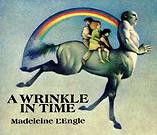
In 1962, when “A Wrinkle in Time,” after 26 rejections, was acquired by John Farrar at Farrar, Straus & Giroux, science fiction by women and aimed at female readers was a rarity. The genre was thought to be down-market and not up to the standards of children’s literature — the stuff of pulp and comic books for errant schoolboys. Even today, girls and grown women are not generally fans. Half of 18- to 24-year-old men say that science fiction is their favorite type of book, compared with only one-fourth of young women…. “A Wrinkle in Time,” the first in a trilogy that was later extended to include two more books, also defied the norm. Though a major crossover success with boys as well (with more than 10 million copies sold to date), the book has especially won over young girls. And it usually reaches them at a particularly pivotal moment of pre-adolescence when they are actively seeking to define themselves, their ambitions and place in the world.
— Just blow past the 2/3rds of this piece that consist of weird gender social-essentialism, because the rest of it is true. (Also, you know, Hunger Games?)
Video Premiere: Eleanor Friedberger's "Heaven"
Eleanor Friedberger’s delicious album “Last Summer” now has a video for the song “Heaven,” directed by Scott Jacobson. Hooray! Please to enjoy. (It’s very gorgeous: put on your headphones and go full-screen with me!)
In other Eleanor news: she is guest-starring on the Portlandia Live tour, beginning February 19th in Philly. But before that, she’s doing her very own West Coast tour, starting February 2nd, wending her way north from San Diego to Seattle. (More info here, and yes, that includes SF and Portland.)
Hey, while we are here: would you like to download her live EP, for free, simply in exchange for going on her mailing list? I certainly would and indeed just have done so. Merge Records would love to make that happen for you, right here.
First Date Queries Not to Utter: "Where Do You Want This?"
“Now a sixth grader’s vocabulary includes the phrase money shot. And a lot of other terms for male ejaculate that sound like verbs from the Nickelodeon channel.”
— Dude. You are not Ron Jeremy.
Ferris Bueller Revisited
“A friend once told me that he thought — knew, actually — that Alan Ruck’s character Cameron was obviously fucking Ferris’ girlfriend behind his back. Next time you see the move, pay close attention to Cameron and Sloane. You’ll never unsee it.”
Egyptian Deities Ate Well
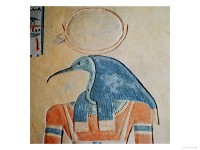
“Ancient Egyptians placed food in the mouths or stomachs of animal mummies, suggesting that animals were treated equally to humans in death and perhaps also in life. In this case the mummies were sacred ibis birds In a study, published in the Journal of Archaeological Science, the findings are the first known examples of food placed directly in animal mummies.”
— Here’s an interesting, animal-lover’s perspective on the ancient practice of stuffing birds with food before killing them and mummifying them as sacrificial offerings. I would think they were perhaps making fois gras. Surely Thoth, the god of wisdom, would have had a sophisticated palate.
